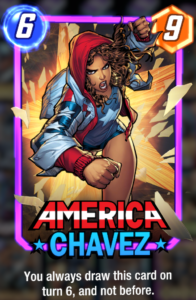Introduction
In the last Marvel Snap article we have done numerical compuation of the most efficient energy curves in the general case (Finding The Perfect Energy Curve In Marvel Snap). A logical follow-up would be to include the simplest consistency cards: Quicksilver, Domino and America Chavez in the analysis. Those cards have been objects of various mathematical analysis in the community already. In this article we would mostly concentrate on efficiency impact.
It would also be valuable to check out how the optimal curve evolves when consistency cards are added. How many 1s would an optimal Quicksilver deck play and how many 2s would a Domino build run? Let’s start our investigation.
Quicksilver

Quicksilver always starts in the initial hand, which guarantees a 1-cost starter. The card has 2 power and no other effects. Let’s assume that one energy crystal is worth 2 points on average. Meta level 1p starter cards play for around effective 3 points thanks to special effects (Korg, Iceman, Nightcrawler). To close the gap, Quicksilver should improve mana efficiency of the deck by no less than 0.5 (peak performance of natural curves was ~20.25), or rely on other synergies . Let’s see if this is achieved.
Quicksilver inclusion could rise efficiency to about 20.55 energy spend per game (~+0.3). It is not enough for Quicksilver to be a meta card unless other synergies are present.
Decks running Quicksilver would lower the number of 1s played from 2-3 to 1-2. The number of 2s must be high enough to make full spend in turn 2 probable. A standard would be to play 4x or 5x cost 2 cards. Quicksilver is still a decent pick in the starting set, with roughly 2.5 points value for 1 energy cost.
Domino

Domino plays even a bit lower below meta power level than Quicksilver. With 3 raw points, Domino trades one point down to simple cards like Medusa or Mister Sinister (not to mention Angela…). Moreover, Domino doesn’t provide any extra effect but for consistency improvement.
At the first sight we could then say that outside possible synergies, Domino wouldn’t be a casual pick. Nevertheless, let’s see how good efficiency improvement offered by Domino really is…
Domino effect is just as strong as Quicksilver’s (very, very slightly better). Builds based on Domino also deplete the 2s region to 1-2 level. At the same time, a bit more 1s are played (3-4) and more 3s (~4).
America Chavez

Quicksilver, Domino and America Chavez effects look pretty similar, but number makes difference. While Quicksilver and Domino inhibit drawing crucial cards in turns 1-5, America Chavez effectively thins the deck by 1 and increases the chances to draw important tools early (you could use Calculator to get exact probabilities when needed)
On the other hand, the energy efficiency effect on America seems a bit weaker than Quicksilver and Domino at the first sight. The latter two guarantee playing on curve at the stage most reliant on RNG, while America doesn’t. Let’s see if that’s true.
Surprise! America Chavez effect not only provides better thinning, but also better curve efficiency. At the same time, the drawback is low America raw value (~3 points below the meta level, think of Hulk).
America Chavez decks play more 1s than usual builds, but this is a bit artificial; having guaranteed last turn, it is beneficial to lower the profile. Going this way though forces playing exactly Chavez as the last card, which is often suboptimal.
Quicksilver + Domino
Let’s see how well two low cost consistency tools perform when combined.
Playing both Quicksilver and Domino is not a good idea in general, as the effects apparently do not add well. In fact the peak performance is comparable with what is achieved by America Chavez alone.
Having guaranteed turns 1 and 2, optimal decks run 4-5 cards of 3-cost, which are also used to build up perfect finish play.
Striking 100% With Full Squad
Let’s check out combined performance of Quicksilver + Domino + America to establish the energy efficiency limit.
20.94 / 99.7% is the average efficiency limit in Marvel Snap! Note how the presence of America Chavez brought back up 1s and 2s in spite the deck running both Quicksilver and Domino.
Closure
Hope you enjoyed this supplementary study on Quicksilver, Domino and America Chavez in the context of energy curve efficiency. I found it especially interesting to observe how profile changes in Quick/Domino optimal builds. Also the impact of America Chavez surprised me. For more data used in this and other Snap articles, check out the google drive folder.
This is probably the last article of my Marvel Snap detour. I could only pray for these materials (and the game) to withstand the test of the time. May the cubes be with you!
What would be leriohub agenda for the next days then? Well, take a bet…

